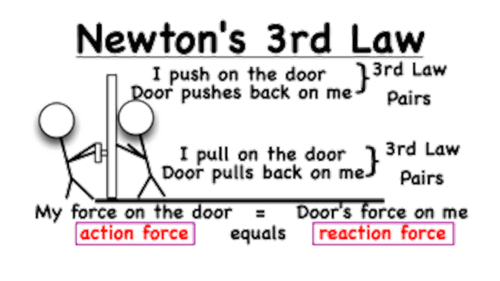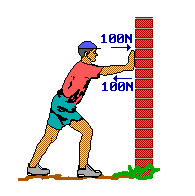Newton's Third Law of Motion
claimed by Karan Shah

Main Idea


Newton’s Third Law of Motion describes a push or pull that acts on an object as a result of its interaction with another object. According to this law for every action there is an equal and opposite re-action. This means that for every force there is a reaction force that is equal in size, but opposite in direction. Meaning that when an object 1 pushes another object 2 then object 1 gets pushed back with equal force but in the opposite direction. The third law of motion is also referred to as the action-reaction law because both the forces are part of a single interaction and neither force can exist without the other.
A Mathematical Model

An important concept to remember about Newton's Third Law of Motion is that the two forces are of the same type. For example, when you throw a ball in the sky the Earth exerts a gravitational force on the ball and the ball also exerts a gravitational force on that is equal in magnitude and opposite in direction on the earth.
(e.g., if the road exerts a forward frictional force on an accelerating car's tires, then it is also a frictional force that Newton's third law predicts for the tires pushing backward on the road).
A Computational Model
How do we visualize or predict using this topic. Consider embedding some vpython code here Teach hands-on with GlowScript
Examples
Be sure to show all steps in your solution and include diagrams whenever possible
Simple
Middling
Difficult
Connectedness
- How is this topic connected to something that you are interested in?
- How is it connected to your major?
- Is there an interesting industrial application?
History
Put this idea in historical context. Give the reader the Who, What, When, Where, and Why.
See also
Are there related topics or categories in this wiki resource for the curious reader to explore? How does this topic fit into that context?
Further reading
Books, Articles or other print media on this topic
External links
Internet resources on this topic
References
This section contains the the references you used while writing this page